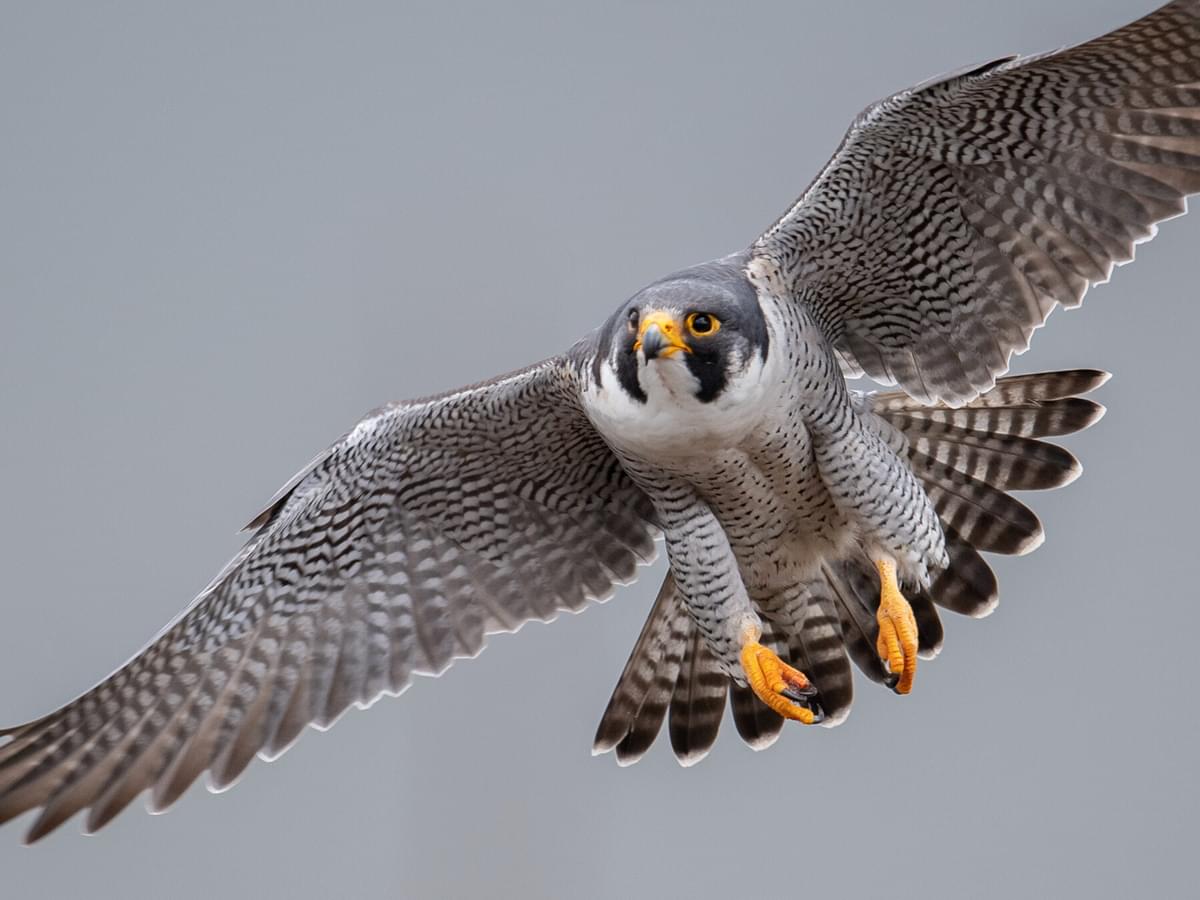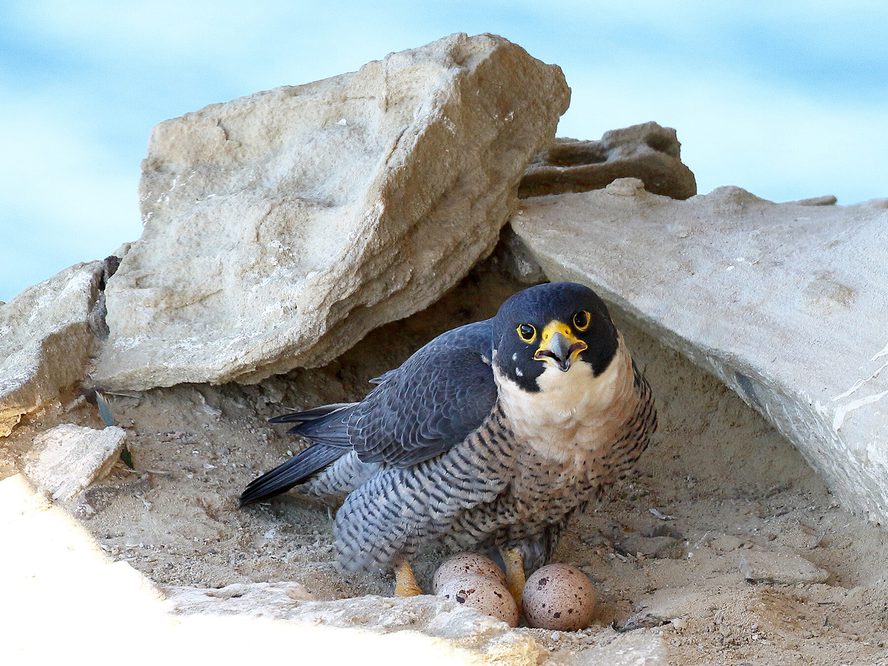Jump to Section
Male vs Female Peregrine Falcons: How To Tell The Difference
Last updated: 6 June 2022

The peregrine falcon is a recognizable and widespread raptor, found throughout North and South America, Europe, Asia, and parts of Africa. Within the United States, these magnificent birds are generally found along the east and west coasts and in the southwest. They also have a breeding corridor along the Rocky Mountain Range.
The peregrine is solitary throughout most of the year, except during breeding season. If you have had the pleasure of observing a mated pair, perhaps you have wondered how to differentiate the two.
Though males and females are similar in color, they feature a few distinct differences, primarily in size and breast markings.
In this article, we will discuss the differences between male and female peregrine falcons so that you can more easily tell them apart. The following paragraphs will cover both physical and behavioral variations. Read on to discover more!

Close up of a perched Peregrine Falcon
How can you tell if a peregrine falcon is male or female?
Male and female peregrine falcons have similar plumage, which can make it difficult to tell one from the other at first glance. Though there are a couple of minor differences in coloration, the sexes are more easily identified by size. Female peregrine falcons are significantly larger than the males, weighing up to 50% more.
A female appears not only taller but also broader than her partner, with a larger head and thicker neck. The male is generally smaller and more streamlined. In flight, he will be much more agile and aerodynamic.

Male (left) and female (right) Peregrine Falcons feeding on prey
What does a male peregrine falcon look like?
A male peregrine falcon has dark grayish-blue plumage on the back. The head and neck are generally a darker charcoal color. A male’s throat and upper chest are often solid white, occasionally, speckled with brown-gray spots. The breast and underside are typically white with a faint pink tint, sometimes striped with gray.
Plumage does not vary significantly based on the season. The most notable difference is seen in the male’s bare parts, which appear brighter during the breeding season.
Bare parts include the facial skin around the eyes and beak, the legs, and the feet. All of which are bright yellow during the breeding season.

A male Peregrine Falcon in flight
What does a female peregrine falcon look like?
A female peregrine falcon has the same dark gray plumage on the back, neck, and head. The throat, chest, and underside are a reddish-beige, rather than white like the male, and more heavily marked. The throat features brownish vertical stripes, while the breast and belly show distinct dark brown horizontal lines.
The female’s reddish-beige chest marks the biggest difference between her and the male as far as plumage is concerned. A female peregrine’s facial skin, legs, and feet are also more of a dull yellow, in contrast to the male’s bright yellow coloration during the breeding season.

A perched female Peregrine Falcon
What color is a female peregrine falcon?
The female peregrine has dark blue-gray plumage on her back, with a pale reddish-beige chest and belly. Her breast is also marked with brownish stripes. Overall, the female is more buff in color, featuring less white than the male, and has more distinct markings.
What is a female peregrine falcon called?
A female peregrine is called the falcon, whereas a male is known as the tiercel.

Juvenile Peregrine Falcon in flight
Are female peregrine falcons bigger than males?
Female peregrine falcons are significantly larger than males. They generally weigh about two pounds and are 18 to 21 inches long.
Males, on the other hand, weigh about 1.25 pounds and only reach 15 to 18 inches long. Females are thicker than males, overall, with broader necks and shoulders.
Behavior differences
Female and male peregrine falcons have a few behavioral differences that can help you differentiate the two also. Most notably, their calls vary slightly and they exhibit different behaviors regarding nesting and feeding young.
We will discuss these differences in more detail in the following paragraphs.

Female (right) and male (left) perched Peregrine Falcons
Singing and calls
Female and male peregrines have a similar collection of calls. The primary difference lies in the sound frequencies. Females have a lower sound range compared to the male's higher, more harmonic calls. Peregrine vocalizations can be separated into four categories - the cack, eechip, chitter, and wail. The cack is generally an alarm call. When given by the female, the kak kak kak is much more rapid and less harmonic.
The eechip call consists of a three-part Ku-ee-chip sound. Both sexes use this call, although the exact motivation is not known. Wild birds appear to utilize it when intruders are near the nest. It has also been observed during mating behaviors. When the female produces this call the chip sounds more like a chup, a lower, more rounded sound than the crisp chip of the male.
The chitter is a short, often repeated chi chi chi sound. This call is most often given by the male during mating but can be heard from both sexes when something has alarmed them.
The wail is the final call category. It is a long call that is either repeated or continued. Both sexes utilize this call in different contexts, including during food transfer, copulation, territorial defense, or when a male is without a mate.
Females most often use the food and copulation wails. Occasionally, they also give the territorial defense (or agonistic) wail when threatened.

A calling Peregrine Falcon
Lifespan difference
There is not a significant difference in the lifespan of a female versus a male peregrine. Either sex will typically live between 15 and 19 years.
Young falcons in their first year are more at risk, with a 60% mortality rate. Once these birds reach adulthood, they have fewer predatory threats.
Nesting and feeding
When nesting season begins, the male typically makes scrapes on a variety of ledges, then the female picks the final nesting site for egg-laying. Once she has laid the eggs, both the male and female participate in incubation. Overall, the female spends more time on the nest than her partner, while the male provides most of their food.
Once the nestlings have hatched, the female remains at or near the nest during brooding. The male provides food for the female and young for the first half of the nestling period. After about 10 days, the female begins to leave the nest more frequently to hunt and provide food as well.

A female Peregrine Falcon looking after her young chicks
Can female peregrine falcons raise young alone?
A female peregrine falcon could potentially raise young alone. However, her nestlings would be at a greater risk. Typically, the female relies heavily on her mate to provide food periodically during incubation and consistently for the first 10 days after the eggs hatch.
Raising young alone would require the female to frequently leave the nestlings at their most vulnerable. If food can consistently be found near the nest, she may be successful.
However, if she must leave the nest unattended for longer periods, a predator would likely find the unattended chicks.
Do female peregrine falcons call?
Female peregrine falcons have a repertoire of calls that is similar to that of the male. They give the common cack call when sounding the alarm. You may also hear a female use the eechip (or chup) and chitter calls, which are also variations of alarm sounds.
The wail is the fourth and final type of call in the female peregrines collection. Her wails are generally associated with mating and food sharing or transferring.
On this page
- How can you tell if a peregrine falcon is male or female?
- What does a male peregrine falcon look like?
- What does a female peregrine falcon look like?
- What color is a female peregrine falcon?
- What is a female peregrine falcon called?
- Are female peregrine falcons bigger than males?
- Behavior differences
- Singing and calls
- Lifespan difference
- Nesting and feeding
- Can female peregrine falcons raise young alone?
- Do female peregrine falcons call?




